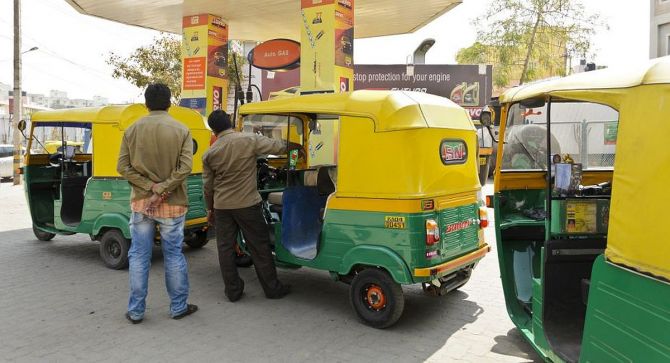The Union Cabinet on Thursday approved a revision in the formula for pricing of natural gas and imposed cap or ceiling price to help cut CNG and piped cooking gas prices by up to 10 per cent.

Natural gas produced from legacy or old fields, known as APM gas, will now be indexed to the price of imported crude oil instead of benchmarking it to gas prices in four surplus nations such as the US, Canada and Russia, Union I&B Miniser Anurag Thakur told reporters after a meeting of the Cabinet.
APM gas will be priced at 10 per cent of the price of basket of crude oil that India imports (Indian basket of crude oil).
The rate such arrived at however will be capped at $6.5 per million British thermal unit.
There will also be a floor or base price of $4 per mmBtu.
The ceiling price is lower than the current rate of $8.57 per mmBtu and would translate into a reduction in prices of piped cooking gas as well as CNG sold to automobiles, he said.
Piped cooking gas prices will be cut by up to 10 per cent across cities while CNG will see a little lower reduction, he said.
Rates of piped cooking gas, called PNG, and CNG have jumped 80 per cent in one year to August 2022.
This follows a spurt in international energy prices.
Following the decision, the CNG price in Delhi will be cut from Rs 79.56 per kg to Rs 73.59 and that of PNG from Rs 53.59 per thousand cubic meters to Rs 47.59.
In Mumbai, CNG will cost Rs 79 per kg instead of Rs 87 and PNG will cost Rs 49 per scm instead of Rs 54.
The Indian basket of crude oil is currently priced at $85 per barrel and 10 per cent of that translates into a price of $8.5 but the cap would mean the APM gas produces, ONGC and Oil India Ltd would get only $6.5 per mmBtu.
These caps and floor prices will be for two years and rates will increase by $0.25 per mmBtu per year thereafter, the minister said.
The changes in the gas pricing formula are based on the recommendations of a committee under Kirit Parikh.
While the committee's recommendation for floor and ceiling as well as indexation has been accepted, the one on annual increment and full deregulation has been changed.
The panel had suggested a 50 cents per mmBtu increase in the $6.50 ceiling every year to slowly move toward the marketing and pricing freedom for APM fields.
Asked about the deregulation, oil secretary Pankaj Jain said the decisions taken by the cabinet have been informed.
Also, rates will be fixed every month instead of the current practice of fixing them bi-annually.
Currently, the government bi-annually fixes prices of locally produced natural gas -- which is converted into CNG for use in automobiles, piped to household kitchens for cooking and used to generate electricity and make fertilisers.
Two different formulas govern rates paid for gas produced from legacy or old fields of national oil companies like Oil and Natural Gas Corporation (ONGC) and Oil India Ltd (OIL), and that for newer fields lying in difficult to tap areas such as deepsea.
The global spurt in energy prices post Russia's invasion of Ukraine has led to rates of locally produced gas climbing to record levels - $8.57 per million British thermal unit for gas from legacy or old fields and $12.46 per mmBtu for gas from difficult fields in six month period ending March 31.
At the April 1 revision, the APM gas price was kept on hold pending Cabinet approval for the change in the pricing formula.
Had the old formula continued, prices of gas from legacy fields would have climbed to $10.7 per mmBtu.
The price of gas from difficult fields was cut to $12.11 per mmBtu.
The government had last year constituted a committee under Kirit Parikh to look at a revision in gas prices that balances both local consumer and producer interest, while at the same time advancing the country's cause of becoming a gas-based economy.
While leaving the formula for difficult fields unchanged, the panel suggested the price band for current production from legacy or old fields, which make up for two-thirds of all gas produced in the country and is currently under the administered price mechanism, or APM, until a full deregulation of prices is implemented in 2027.
The panel suggested a 50 cents per mmBtu increase in the $6.50 ceiling every year to slowly move toward the marketing and pricing freedom for APM fields.
Thakur said the ceiling price covers for the cost of production of producers while protecting consumers particularly CNG users, kitchens using piped cooking gas and fertilizer plants who had grappled with soaring input cost.
APM gas makes up for most of CNG and kitchen gas supplies.
India aspires to become a gas-based economy with the share of natural gas in its primary energy mix targeted to rise to 15 per cent by 2030 from the existing level of around 6.3 per cent.
APM gas fields were allotted to ONGC and OIL before 1999.
Production from these fields do not attract profit-sharing with the government, and their pricing formula is benchmarked to gas prices at international gas hubs in surplus nations every six months based on the weighted average price.
Prices were last revised on October 1 and are now due for revision on April 1.
To incentivize additional production from a new well or well intervention in the nomination blocks, the Kirit Parikh committee recommended a premium of 20 per cent over and above the APM prices for ONGC and OIL till complete freedom.
This has been approved by the Cabinet, he said.
As much as 34 per cent of APM gas is allotted to the power sector in 2021-22, 17 per cent to the fertilizer industry, which impacts food prices, and 22 per cent to the city gas sector.
The committee also recommended that gas should be brought under the Goods and Services Tax, or GST, regime.
Having a common taxation such as GST for gas in lieu of state level VATs, which vary from 3 per cent to as high as 24 per cent, will help develop the market.










